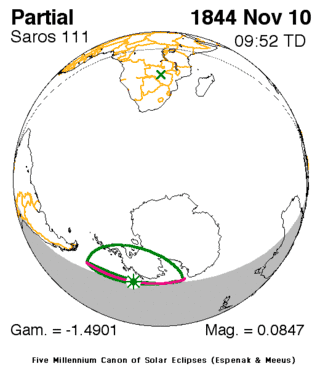Solar eclipse of November 10, 1844
A partial solar eclipse occurred on November 10, 1844 during spring. A solar eclipse occurs when the Moon passes between Earth and the Sun, thereby totally or partly obscuring the image of the Sun for a viewer on Earth. A partial solar eclipse occurs in the polar regions of the Earth when the center of the Moon's shadow misses the Earth.
| Solar eclipse of November 10, 1844 | |
|---|---|
 Map | |
| Type of eclipse | |
| Nature | Partial |
| Gamma | -1.4902 |
| Magnitude | 0.0847 |
| Maximum eclipse | |
| Coordinates | 69.8°S 119.3°W |
| Times (UTC) | |
| Greatest eclipse | 9:51:45 |
| References | |
| Saros | 111 (74 of 79) |
| Catalog # (SE5000) | 9151 |
It was last of four partial eclipses that took place that year, two in the space of two months each, the last one was in July 1819 and covered a part of the Northern Hemisphere.[1] It was the last six of the solar saros 111 cycle of eclipses,[2] the next one was on November 21, 1862 and the last one on January 5, 1935.
Description
The eclipse was visible in much of the peninsular portion of Antarctica and the surrounding islands except for the largest island within Antarctica and the northernmost point and the surrounding islands.
The eclipse started at sunrise at about 40% of the way between South America and the Antarctic Circle and finished at sunset offshore from Antarctica east of the 180th meridian, all of it occurred in the Western Hemisphere. To the earth's surface, the Moon was going to the bottom in the north and then to the right as the axis was rotating east at around 70 south.
It was 5% obscured in the middle of the peninsula up to 8.4% obscuration of the sun at the area of the greatest eclipse. The center of the moon's shadow was missed by over 2,500 km over the area (69.8 S) south of the Antarctic Circle.
The greatest eclipse was in the Pacific Ocean hundreds of miles (or kilometers) northwest of the Antarctic Peninsula at 69.8 S and 119.3 W at 9:51 UTC (7:58 PM local time on November 9).[1]
The subsolar marking was in the Great Zimbabwe (now Zimbabwe) in Africa.
See also
- List of solar eclipses in the 19th century
- List of solar eclipses visible from Antarctica
References
- "Solar eclipse of August 16 1841". NASA. Retrieved March 21, 2017.
- "Solar Saros 111". NASA. Retrieved March 21, 2017.
.jpg.webp)


